
The OMS Work Order management functionality includes the ability to create both asset-specific and non-asset-related tasks. Cost accounting information, including labour, equipment, material, and other costs are applied at the task level to capture the true cost of work against each asset. Tasks can stand alone or be grouped into work orders for roll-up information, including total cost and time to complete. Key features:
Work Orders
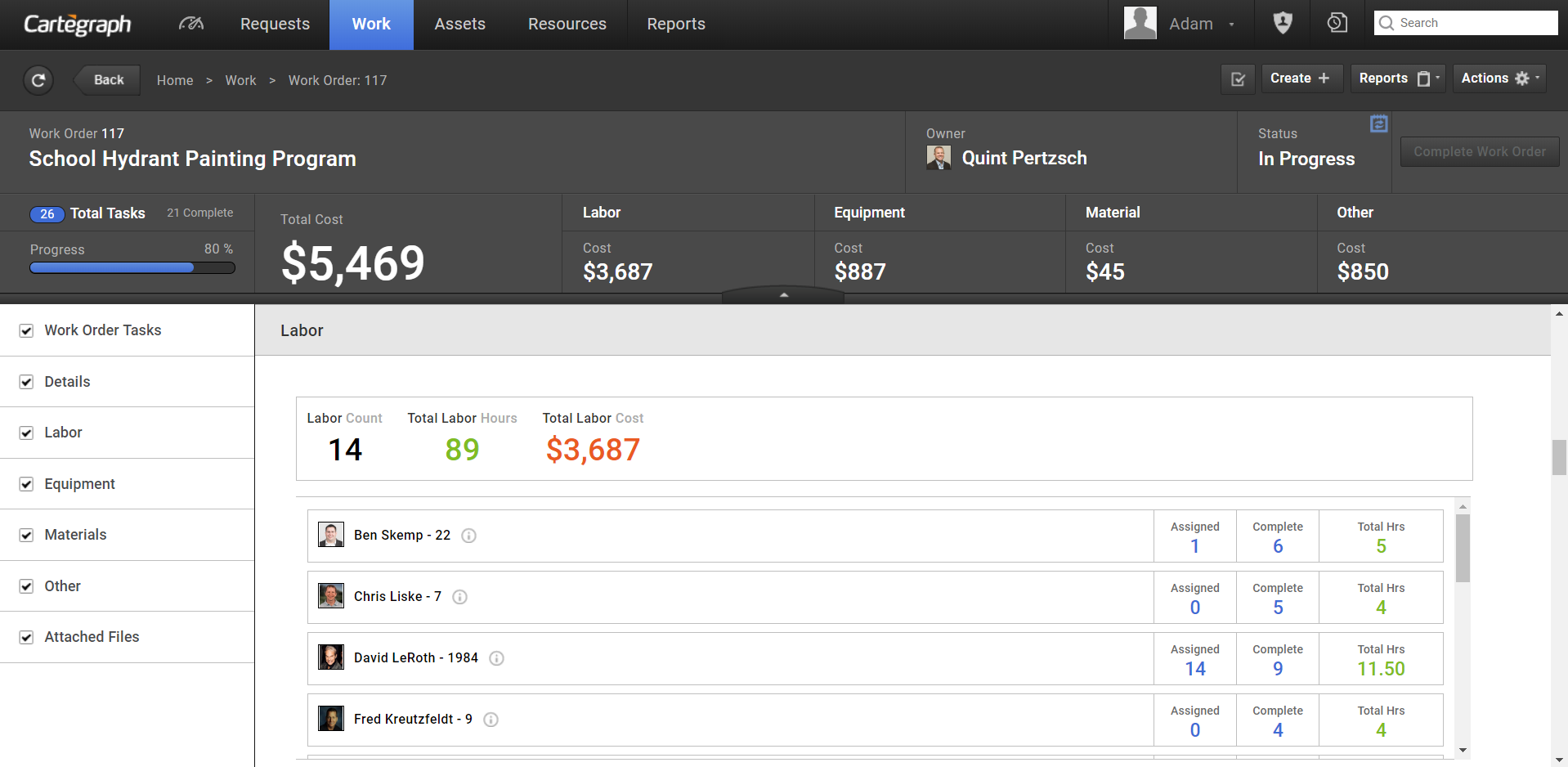
Create a work order at the project level and use it to manage all the tasks necessary to complete it. Instead of assuming that each step of a job or project has been done, you’ll see every related action in meticulous detail — task type and location, overall costs and progress of the work order, when it needs to be completed, and when it needs to be done again.
- A Work Order is a group of tasks.
- Map symbol colors.
- On the List View, as you add Work Order layers, they are assigned a color. This is the color of the work order’s map symbol in the layer.
- On the Detail View, Tasks within the Work Order are assigned colors based on the Tasks’ Status. This is the color of the map symbol for the Tasks.
- As you add Work Order layers, they are assigned a color. This is the color of the work order’s map symbol in the layer.
- The total of work orders in each layer displays to the right of the layer name.
- Work Order’s Start Date must be before the Stop Date.
- To close a Work Order, any associated Tasks must have a status of Completed or Canceled.
- All associated Task dates must fall into the Work Order’s date range.
- Work Orders with associated tasks cannot be deleted.
Repeating Work Orders
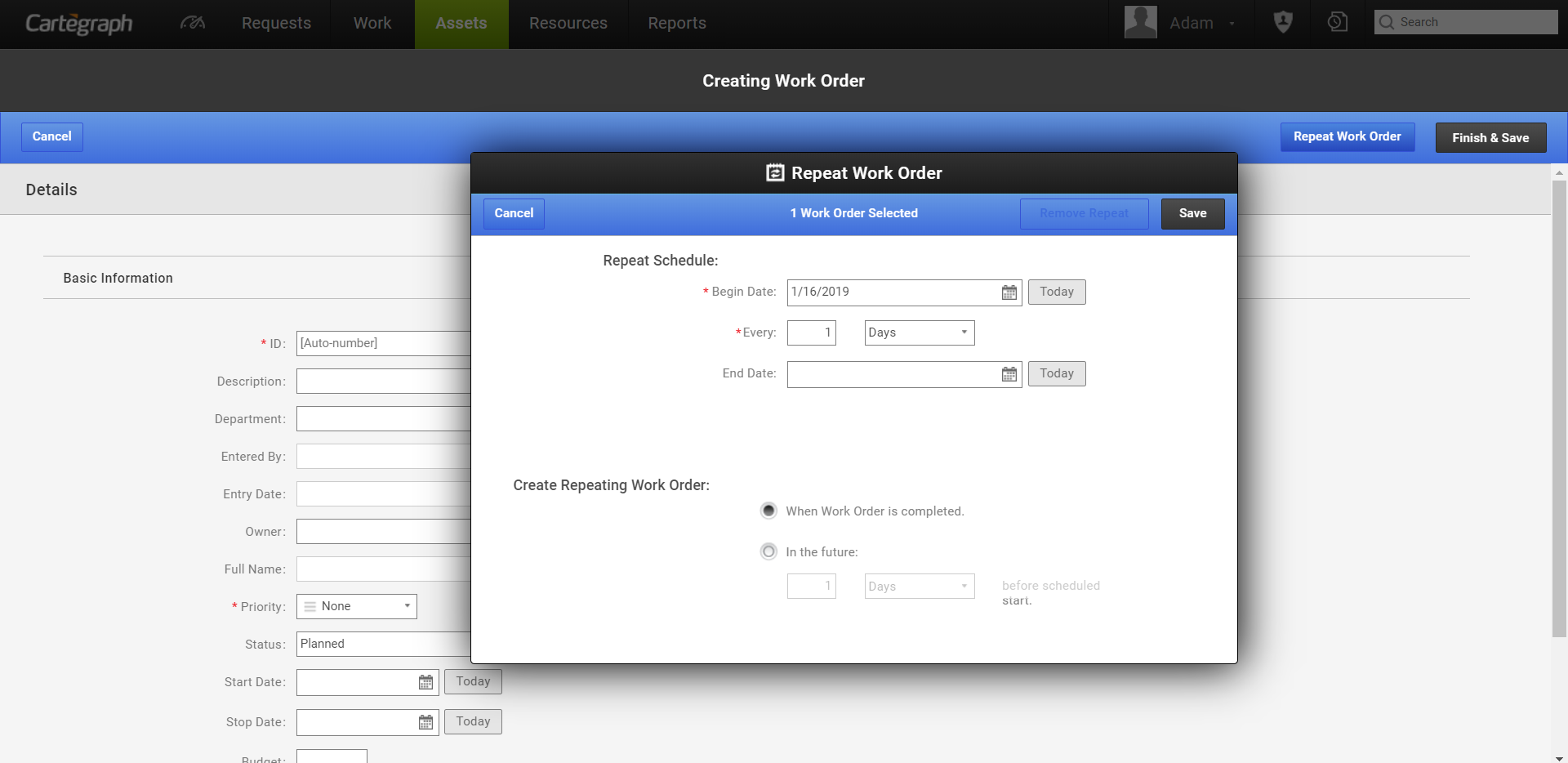
Create routine tasks once, relate them to the work order, and schedule each one to repeat at whatever interval you’d like, as many times as you’d like.
The Repeating Work Orders feature gives users a simple, organized way of scheduling work at regular intervals.
It allows users to group the diverse tasks that comprise a work order and schedule them to repeat under a single heading as opposed to multiple, individual tasks.
- Repeating Work Orders can be scheduled when a Work Order is created or added to an existing Work Order.
- Work Orders can be scheduled to repeat every X number of days, weeks, including days of the week, months, and years.
- Based on user preference, the system will automatically schedule the next instance of a Repeating Work Order:
- Upon completion of the current Work Order
- Or at a later date, regardless of current Work Order status
- Each time a specified Work Order repeats, a new work order is created with the standard set of associated tasks within it.
Tasks

Effectively manage the individual work events that make-up the workday. For assets, infrastructure, equipment, and all the other things you fix and maintain. Easily create and schedule any type of task. Automatically notify users of new and urgent tasks in real time. A task is a record of work. The task shows who worked on it, what resources are used, and when it took place.
Other details include:
- Tasks can only be associated to one asset or equipment record.
- Tasks without an asset association have an Asset Type of Non-Asset.
- Create tasks from Home, Work, Assets, Resources, Requests, and Summary tips for selected records.
- Tasks statuses are Projected, Planned, In Progress, Canceled, or Completed.
- Task Details Shared with Asset and Equipment Records
- The associated task roll-up costs over time display.
- View the maintenance history including when the asset is installed, replaced, inspected, and maintained.
- Track task history.
- View the inspection history.
- Activity List
- Associate each Activity in the Activity library to any Asset Type, including Non-Asset.
- You cannot save or go to the next step, with a value that is not in the list.
- Only Activities related to the selected record display in the Activity field.
Activities
Activities are the most important information stored in a task. An activity is the action performed on an asset. The activity may relate to maintenance, construction, inspection, or administrative actions.
The Activity library is used for all Cartegraph pages. It contains special information about the asset type it applies to and how it impacts Key Dates.
Task Calendar

The Task Calendar displays tasks on a calendar in a week or month view, allowing work to be quickly viewed. Each task’s status, priority image, ID, Activity and Asset are displayed, while a Summary tool tip is available by clicking on the task in the calendar.
All tasks displayed in the calendar come from the grid where the calendar is opened. Any filters applied are used in the calendar, except Map Filter.
The Task Calendar is available on the Task Index screen, the Work Order Tasks section of a Work Order detail, Assigned Tasks in Labor detail, and the Tasks list on a Container Asset Summary tab.
The Status of each task is represented by a color:
- Blue is Projected
- Orange is Planned
- Green is In Progress
- Purple is Completed
- Red is Canceled
When multiple tasks display on the same day, they are displayed using the following order: earliest start date, longest date duration, task priority and then task ID.
Task dates can be adjusted while in the calendar.
Time Sheets
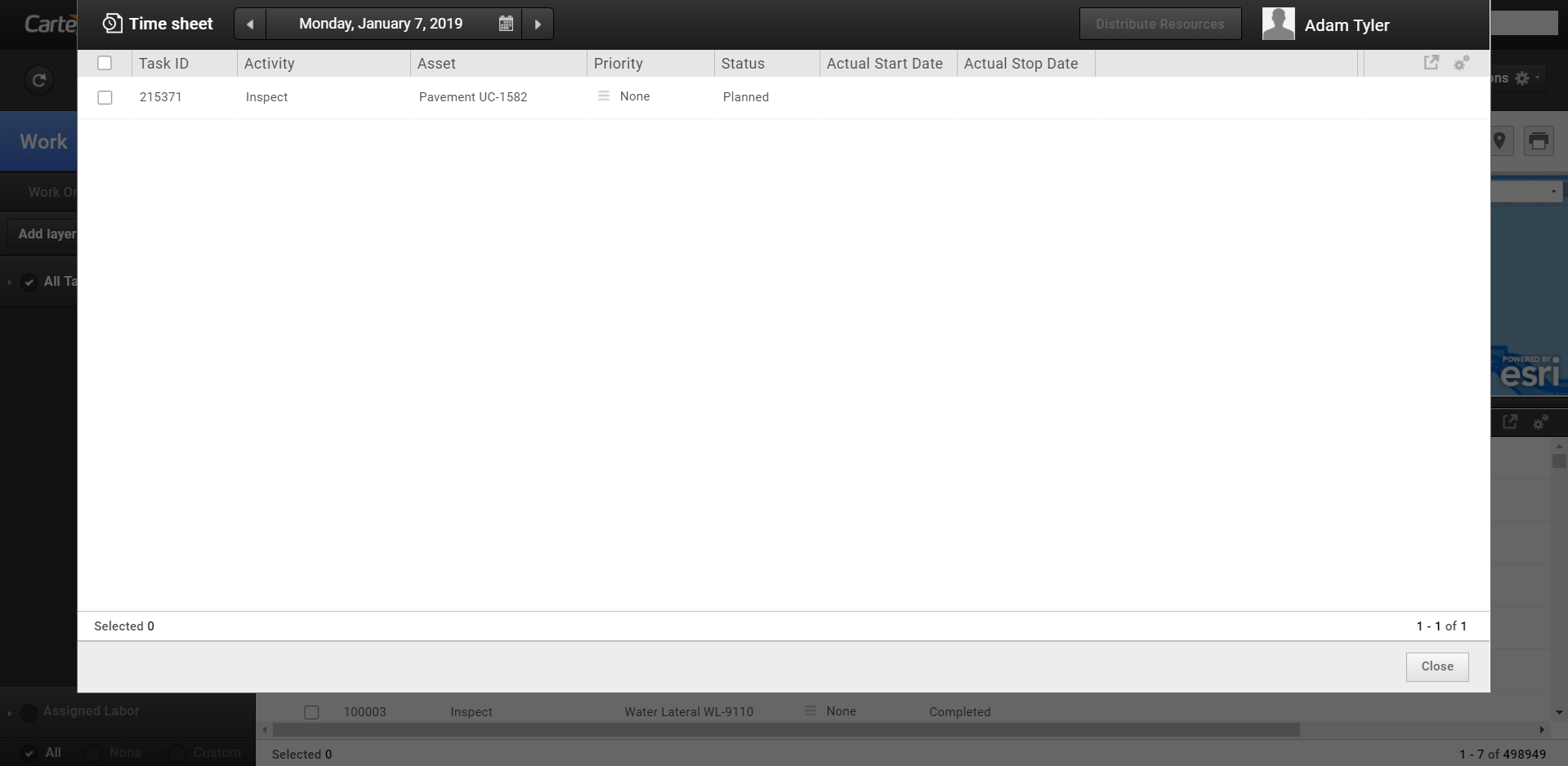
In the office and in the field, Cartegraph makes time sheet management easy and accurate. No more estimates or best guesses. Complete your task, enter your time, and mark it complete. Working on multiple tasks of the same type? Cartegraph also enables you to enter time and resources on multiple tasks at once.
The time sheet is the location for entering Labor, Equipment, Material, and Other resource data for each Task performed and view a Task list.
- Tasks display on Time sheets for the signed in user if:
- If the Task’s status is In Progress or Planned.
- The Task has an Assigned Labor entry associated to this User Account.
- The Task has Labor Log entries with a labor record associated to this User Account.
- Current date falls within the Task Actual Start and Actual Stop dates.
- Signed in users can use the Add Me button to add an entry to the labor log using the labor entry which is associated to the currently signed in user.
- If the Actual Start or Stop date does not exist, the system uses the Estimated Start or Stop date.
- If the Task does not have any dates, the Task always displays on the Task list.
- Click on the Breadcrumb bar or the Task List view to open Time sheets to view your Task list or enter resources.
- With Stock materials the Location field is required.
Distribute Resources
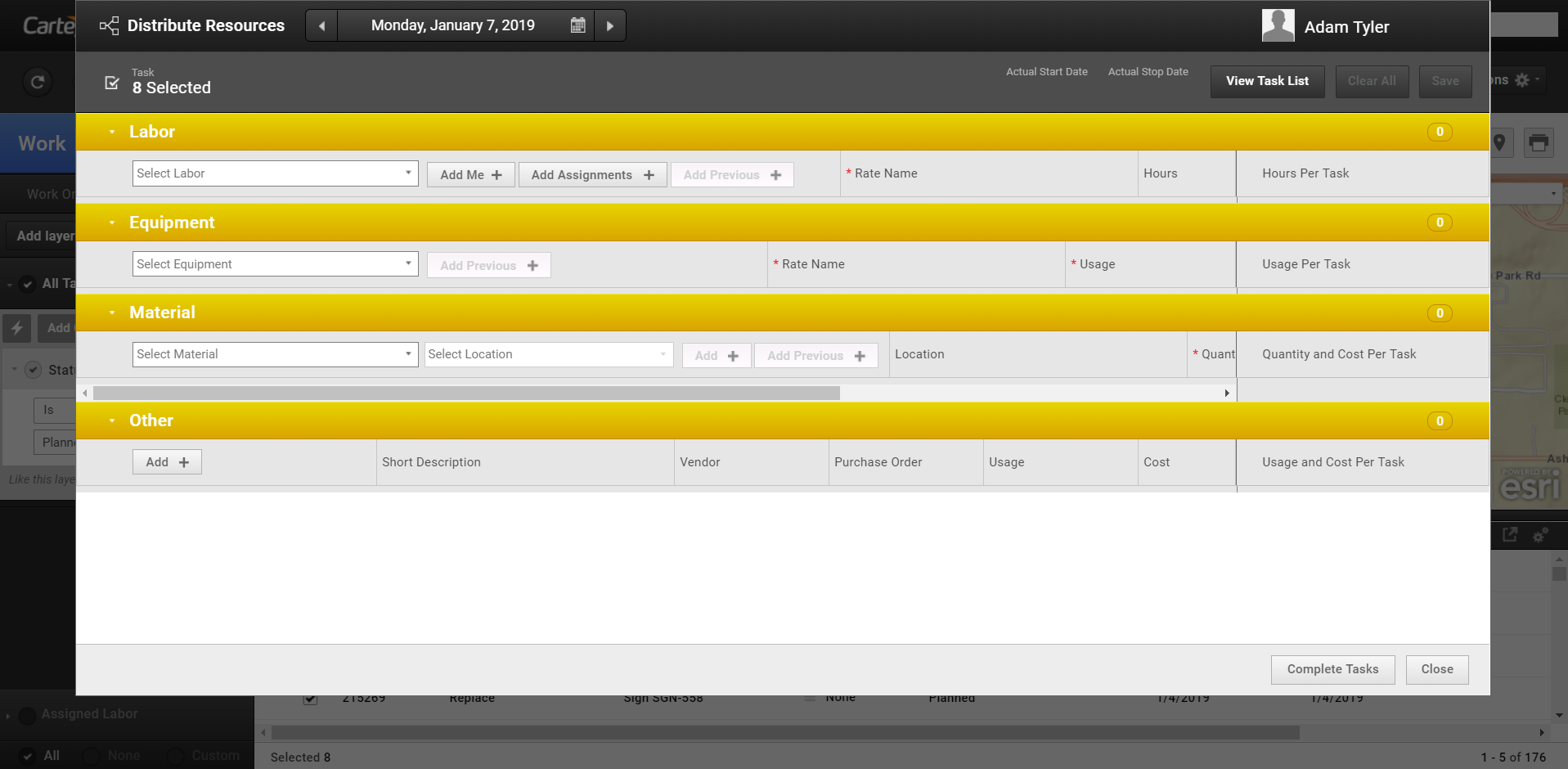
Distribute Resources allows you to quickly enter Labor, Equipment, Material and Other for two or more Tasks and have the hours, usage, and quantity distribute among the selected tasks.
- For each resource entered, the hours, usage, and quantity entered is divided by the total number of Tasks as shown in the header. Other resources cost is divided by the total number of Tasks.
- If the organization is using the Advanced Resources extension, then Material Location is required when entering the stocked Material. If a material exists at multiple locations a detail line will need to be added for each material/location combination.
- Distributed resource amounts round to two decimal points.
- The time sheet calendar highlights the dates eligible for entry.
- Click Clear All to remove all resource rows and return to each resource section’s default state.
- Click Add Assignments to add all labor assigned to the task instead of adding each laborer individually. Additional Labor can be added after using this feature.
- Click Add Previous to quickly enter Labor, Equipment, and Material previously used on the task regardless of the date used. If the resource already exists on that date, it is not added again. Additional Resources can be added after using this feature. For material, a new detail line will be added for each unique material/location.
- If after distributing resources and still need to enter individual resources in the time sheet, close the time sheet or go back to the Task list and use Enter Resources to get the standard time sheet.
- Resources may be distributed across up to 250 tasks.
Task Triggers
You already have enough work to do. Let Cartegraph’s built-in Trigger feature automatically create tasks for you. Just specify the condition and usage limits, and elapsed and scheduled time intervals. The system will do the rest. For more information, refer to the section titled “Advanced Workflow Management”.
Preventative Maintenance
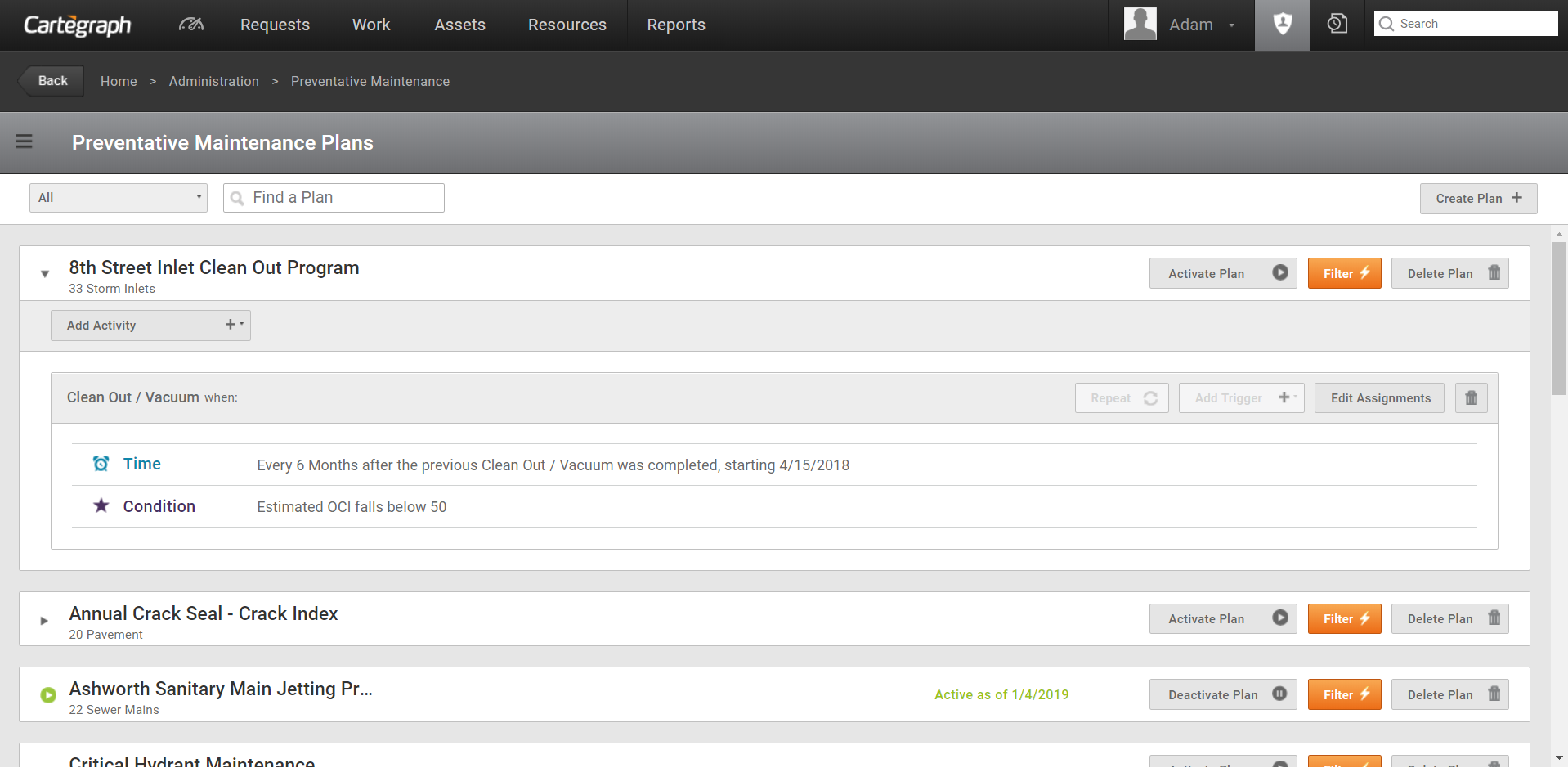
Preventative Maintenance plans are used to prolong the service life of assets through proactive maintenance. Use this functionality to set conditional and/or chronological triggers that, when activated, automatically create the necessary follow-up tasks. The ability to create Preventative Maintenance plans is limited to Cartegraph Administrators only. Here’s what you need to know:
Preventative Maintenance has four parts:
- Plans are a collection of assets you want to maintain. Plans contain Schedules.
- Schedules are the Activities or work that create proactive tasks. Schedules contain Triggers.
- Triggers are the rules governing when to fire the scheduled Tasks (work).
- Labor Assignments define who the scheduled Task is assigned to.
The Administrator determines which tasks can be created by a Preventative Maintenance Plan, how often those tasks can be created, and the triggers that set the task creation process in motion. Triggers are what the system looks for to create a task for the asset.
There are four trigger types:
Condition: Create Tasks based on the condition of an asset. For example, a water hydrants OCI falls below 75, inspect it. The Preventative Maintenance engine compares the current condition of an asset to the value you set in the Plan’s Condition based Trigger. When the current condition falls at or below your set value a Task with the plan’s Activity is created for that asset. To prevent duplicate tasks, condition-based plans always follow the After Complete rule: Do not create tasks if an open Task for the same asset and activity already exists.
Time: Create Tasks after some amount of time has passed. For example, repaint water hydrants every two years. The Preventative Maintenance engine looks at the last time the plan’s maintenance activity was completed and creates the tasks when the user-specified time interval has passed. For example, the time interval of two years does not start until the current Repaint task is completed. Similar to condition triggers, time Triggers follow the After Complete rule.
Repeat: This is a type of time trigger and is different from the time trigger:
- Does not follow the After Complete Rule so you could end up with more than one open task to do the same thing for the same asset
- Does not base the interval on the completion of a task. It starts as soon as the interval ends
- For example, Storm Outlets are required by the EPA to be inspected twice a year or every 6 months. If you schedule the first inspection task for June 1 and don’t complete that task until August 1, the next task is remains scheduled for Dec. 1
Usage: Available for only Equipment Preventative Maintenance plans. Cartegraph recommends always combing usage and time triggers for equipment plans. This is because without a time trigger a piece of equipment could miss the usage trigger and needs the fallback of the time trigger, similar to oil changes for vehicles.
User Interface
- Analytics Dashboard
- Navigation Persistence
- Global Search
- Table of Contents/ Layers
- Map Tools
- Documents Attachments
- List View Data Export
- More Information…
Request Management
Work Management
- Work Orders
- Repeating Work Orders
- Tasks
- Activities
- Task Calendar
- Time Sheets
- Distribute Resources
- Task Triggers
- Preventative Maintenance
- More Information…
Asset Management & Analytics
Resource & Inventory Management
Report Management
Mobile Management
- Cartegraph for iPad and Cartegraph One Feature Comparison
- Cartegraph for iPad
- Cartegraph One
- More Information…
Workflow Management
System Management
- Structure Manager
- Library Manager
- Layout Manager
- Esri and Active Directory
- Security Role Administration
- System Licensing
- System Requirements
- More Information…
